2015 DODGE GRAND CARAVAN radio antenna
[x] Cancel search: radio antennaPage 260 of 703
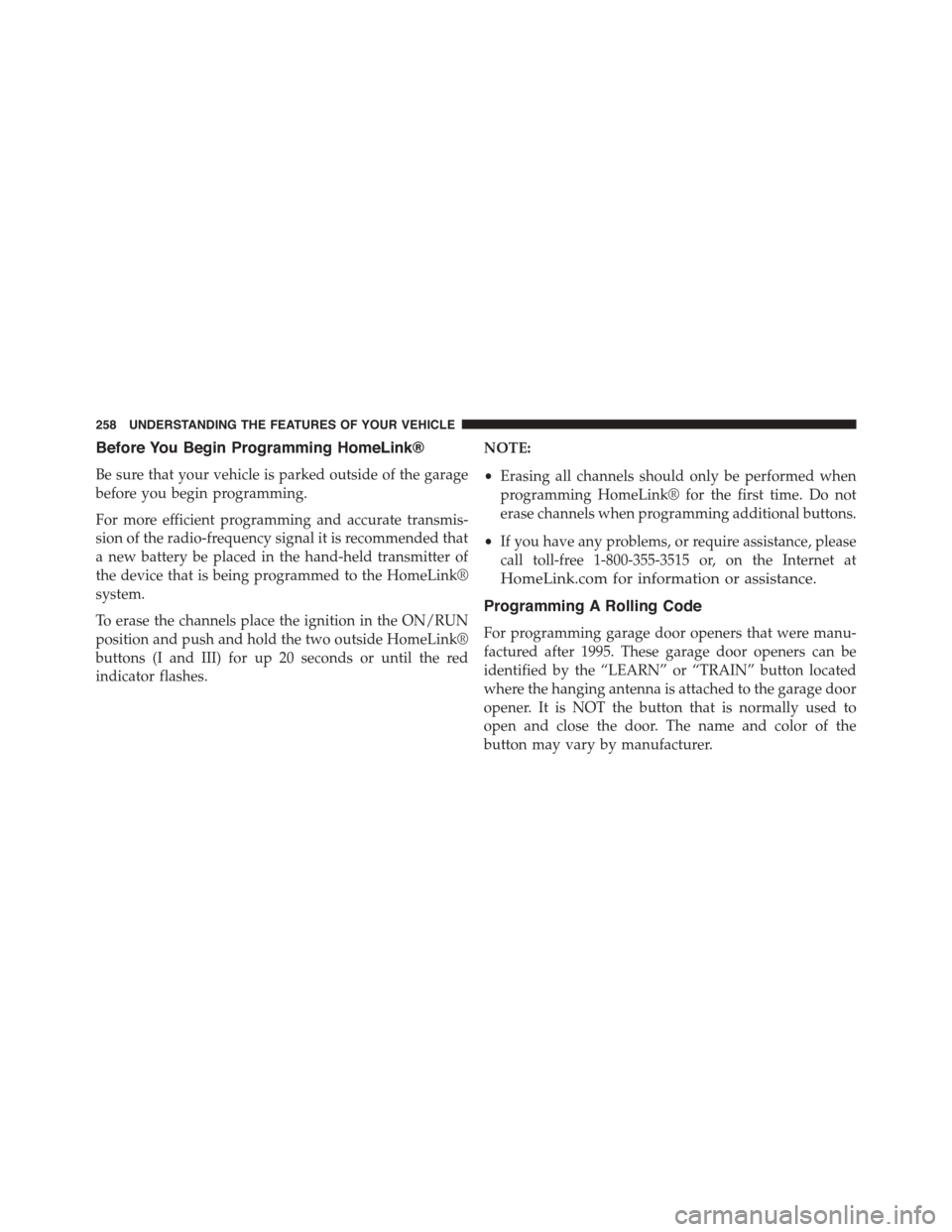
Before You Begin Programming HomeLink®
Be sure that your vehicle is parked outside of the garage
before you begin programming.
For more efficient programming and accurate transmis-
sion of the radio-frequency signal it is recommended that
a new battery be placed in the hand-held transmitter of
the device that is being programmed to the HomeLink®
system.
To erase the channels place the ignition in the ON/RUN
position and push and hold the two outside HomeLink®
buttons (I and III) for up 20 seconds or until the red
indicator flashes.
NOTE:
•Erasing all channels should only be performed when
programming HomeLink® for the first time. Do not
erase channels when programming additional buttons.
•If you have any problems, or require assistance, please
call toll-free 1-800-355-3515 or, on the Internet at
HomeLink.com for information or assistance.
Programming A Rolling Code
For programming garage door openers that were manu-
factured after 1995. These garage door openers can be
identified by the “LEARN” or “TRAIN” button located
where the hanging antenna is attached to the garage door
opener. It is NOT the button that is normally used to
open and close the door. The name and color of the
button may vary by manufacturer.
258 UNDERSTANDING THE FEATURES OF YOUR VEHICLE
Page 376 of 703
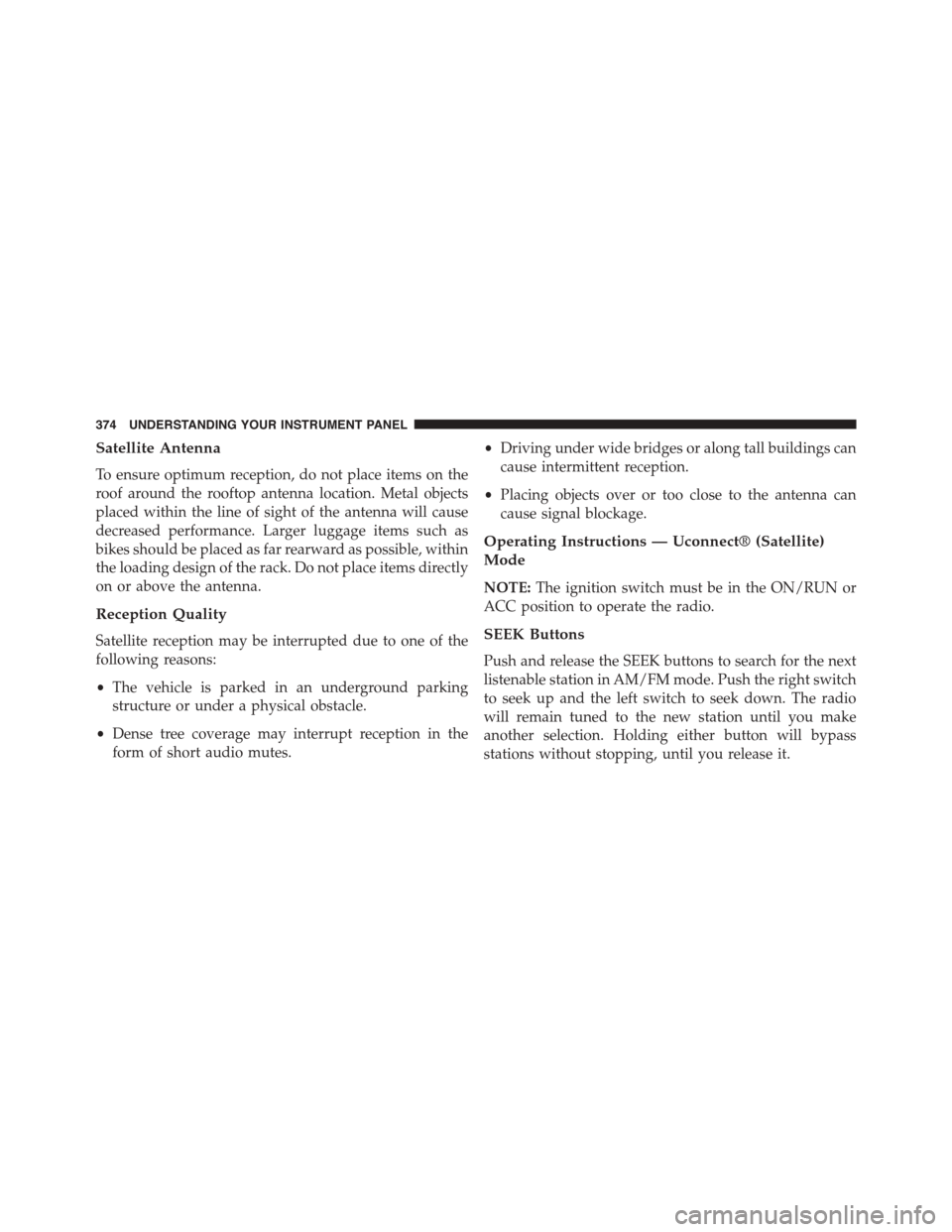
Satellite Antenna
To ensure optimum reception, do not place items on the
roof around the rooftop antenna location. Metal objects
placed within the line of sight of the antenna will cause
decreased performance. Larger luggage items such as
bikes should be placed as far rearward as possible, within
the loading design of the rack. Do not place items directly
on or above the antenna.
Reception Quality
Satellite reception may be interrupted due to one of the
following reasons:
•The vehicle is parked in an underground parking
structure or under a physical obstacle.
•Dense tree coverage may interrupt reception in the
form of short audio mutes.
•Driving under wide bridges or along tall buildings can
cause intermittent reception.
•Placing objects over or too close to the antenna can
cause signal blockage.
Operating Instructions — Uconnect® (Satellite)
Mode
NOTE:The ignition switch must be in the ON/RUN or
ACC position to operate the radio.
SEEK Buttons
Push and release the SEEK buttons to search for the next
listenable station in AM/FM mode. Push the right switch
to seek up and the left switch to seek down. The radio
will remain tuned to the new station until you make
another selection. Holding either button will bypass
stations without stopping, until you release it.
374 UNDERSTANDING YOUR INSTRUMENT PANEL
Page 434 of 703
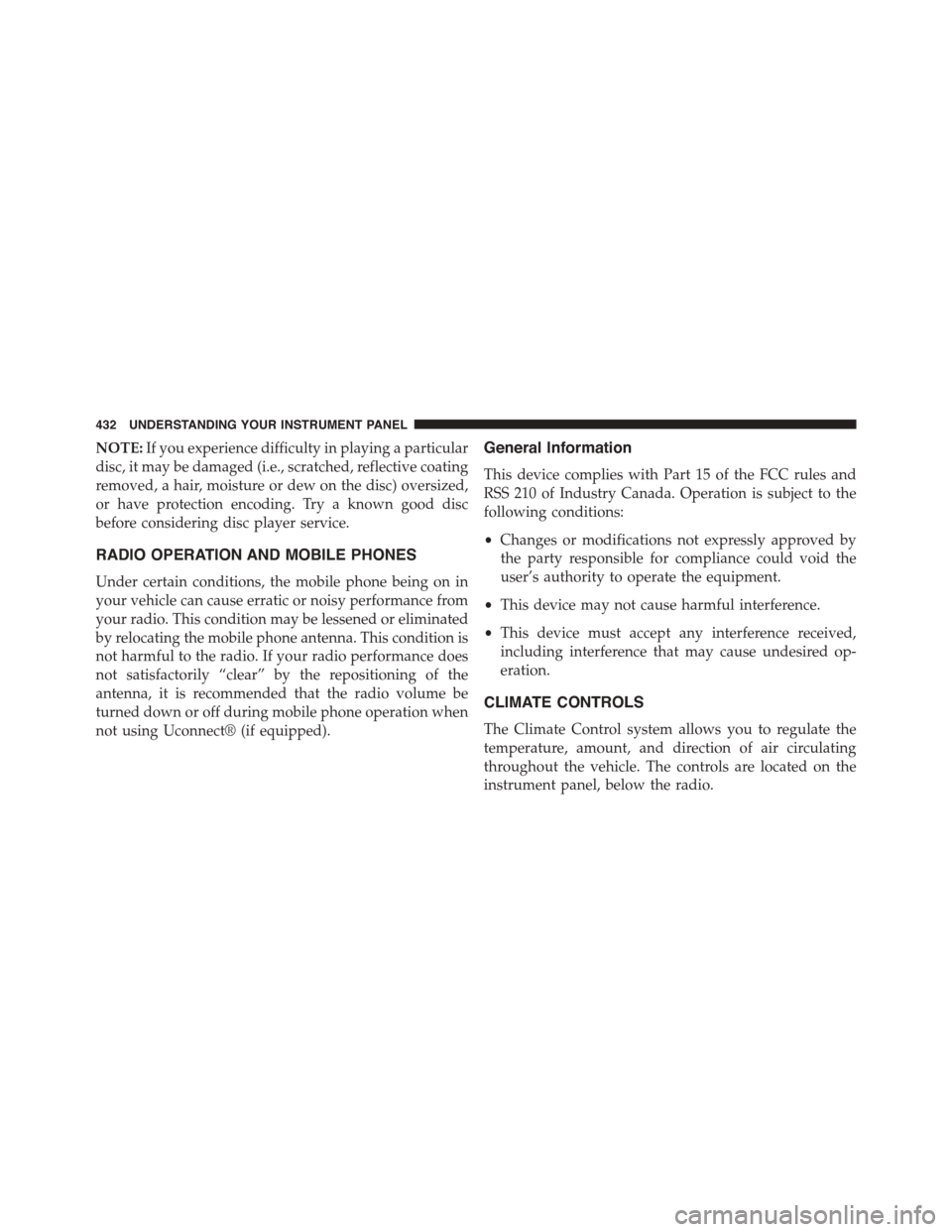
NOTE:If you experience difficulty in playing a particular
disc, it may be damaged (i.e., scratched, reflective coating
removed, a hair, moisture or dew on the disc) oversized,
or have protection encoding. Try a known good disc
before considering disc player service.
RADIO OPERATION AND MOBILE PHONES
Under certain conditions, the mobile phone being on in
your vehicle can cause erratic or noisy performance from
your radio. This condition may be lessened or eliminated
by relocating the mobile phone antenna. This condition is
not harmful to the radio. If your radio performance does
not satisfactorily “clear” by the repositioning of the
antenna, it is recommended that the radio volume be
turned down or off during mobile phone operation when
not using Uconnect® (if equipped).
General Information
This device complies with Part 15 of the FCC rules and
RSS 210 of Industry Canada. Operation is subject to the
following conditions:
•Changes or modifications not expressly approved by
the party responsible for compliance could void the
user’s authority to operate the equipment.
•This device may not cause harmful interference.
•This device must accept any interference received,
including interference that may cause undesired op-
eration.
CLIMATE CONTROLS
The Climate Control system allows you to regulate the
temperature, amount, and direction of air circulating
throughout the vehicle. The controls are located on the
instrument panel, below the radio.
432 UNDERSTANDING YOUR INSTRUMENT PANEL
Page 641 of 703
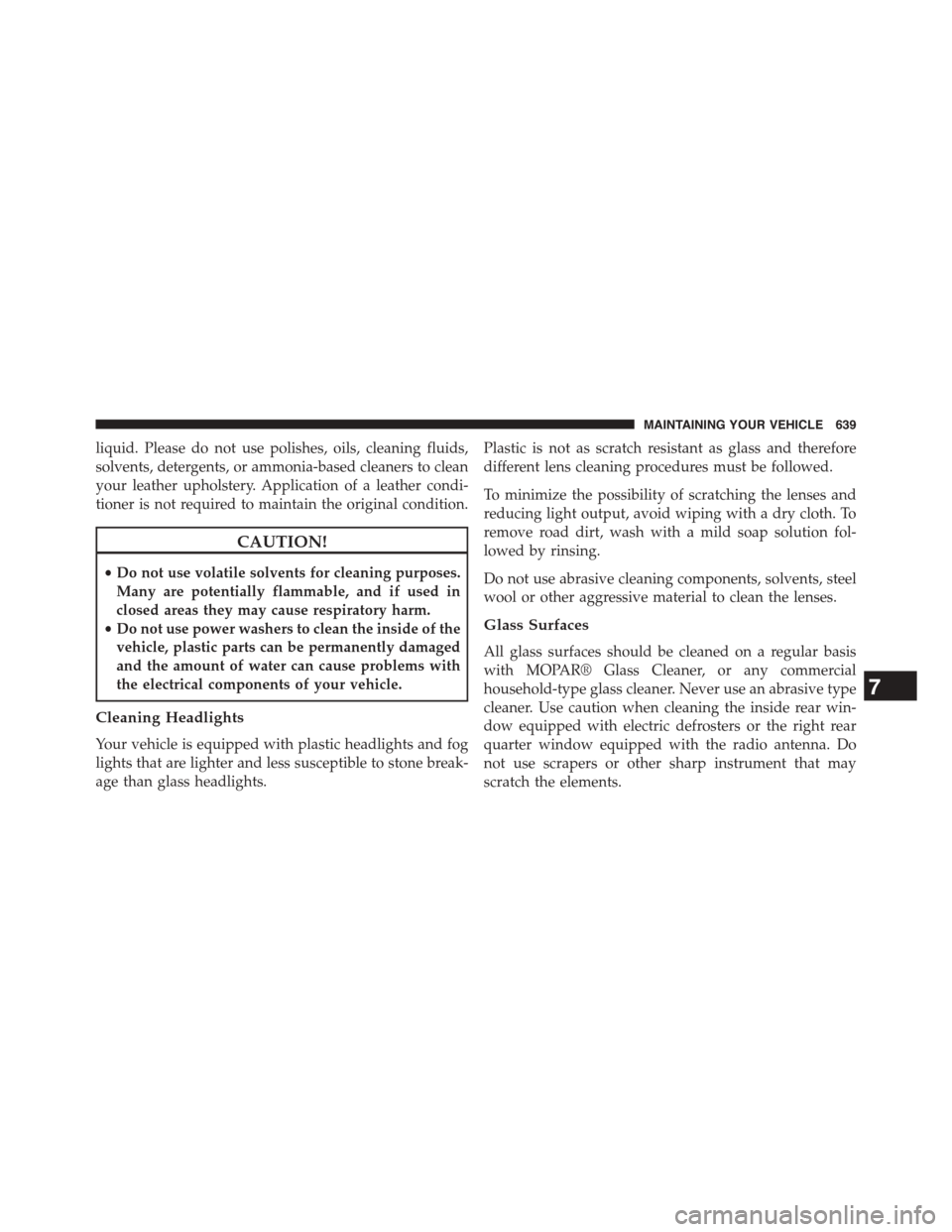
liquid. Please do not use polishes, oils, cleaning fluids,
solvents, detergents, or ammonia-based cleaners to clean
your leather upholstery. Application of a leather condi-
tioner is not required to maintain the original condition.
CAUTION!
•Do not use volatile solvents for cleaning purposes.
Many are potentially flammable, and if used in
closed areas they may cause respiratory harm.
•Do not use power washers to clean the inside of the
vehicle, plastic parts can be permanently damaged
and the amount of water can cause problems with
the electrical components of your vehicle.
Cleaning Headlights
Your vehicle is equipped with plastic headlights and fog
lights that are lighter and less susceptible to stone break-
age than glass headlights.
Plastic is not as scratch resistant as glass and therefore
different lens cleaning procedures must be followed.
To minimize the possibility of scratching the lenses and
reducing light output, avoid wiping with a dry cloth. To
remove road dirt, wash with a mild soap solution fol-
lowed by rinsing.
Do not use abrasive cleaning components, solvents, steel
wool or other aggressive material to clean the lenses.
Glass Surfaces
All glass surfaces should be cleaned on a regular basis
with MOPAR® Glass Cleaner, or any commercial
household-type glass cleaner. Never use an abrasive type
cleaner. Use caution when cleaning the inside rear win-
dow equipped with electric defrosters or the right rear
quarter window equipped with the radio antenna. Do
not use scrapers or other sharp instrument that may
scratch the elements.
7
MAINTAINING YOUR VEHICLE 639
Page 682 of 703
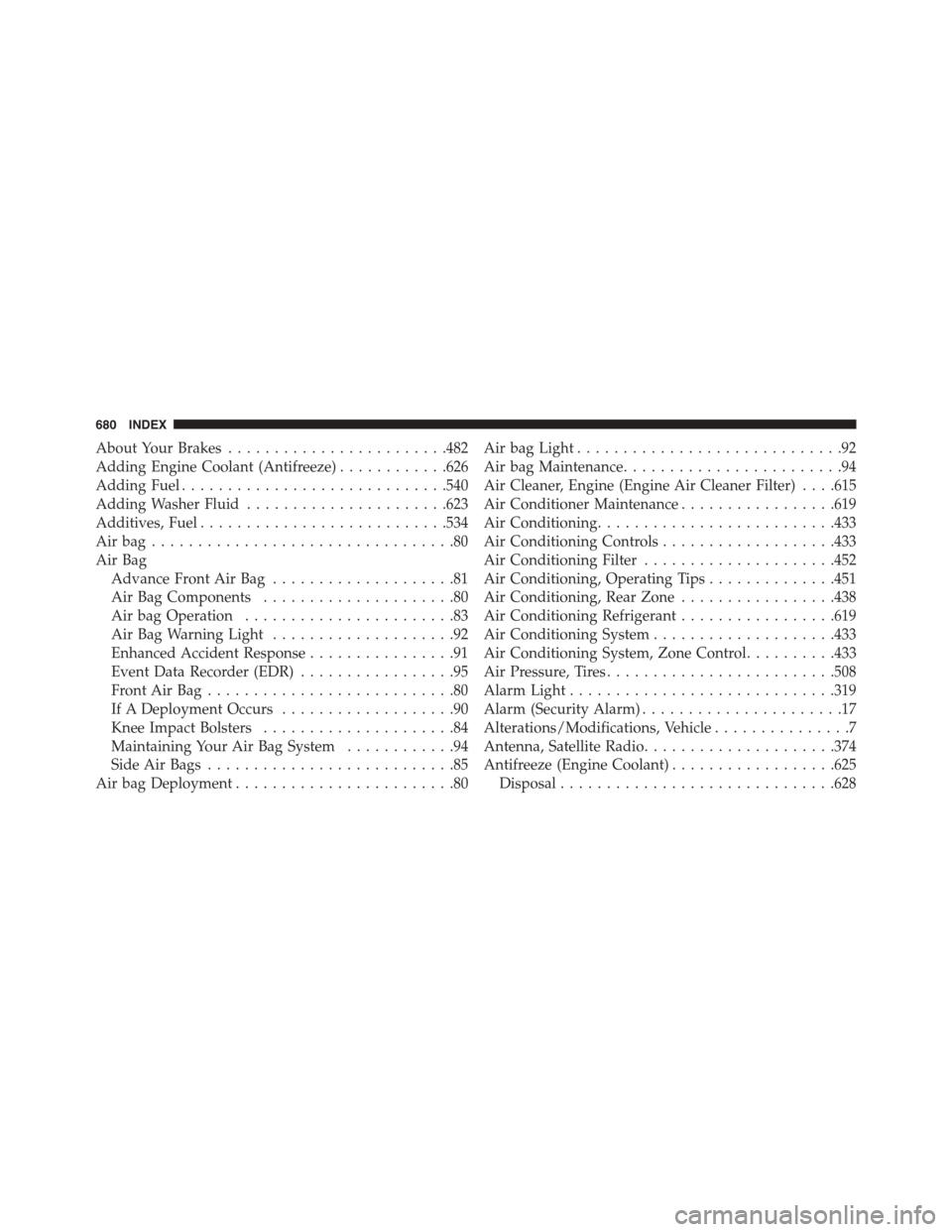
About Your Brakes........................482
Adding Engine Coolant (Antifreeze)............626
Adding Fuel.............................540
Adding Washer Fluid......................623
Additives, Fuel...........................534
Air bag . . . . . . . . . . . . . . . . . . . . . . . . . . . . . . . . .80
Air Bag
Advance Front Air Bag....................81
Air Bag Components.....................80
Air bag Operation.......................83
Air Bag Warning Light....................92
Enhanced Accident Response................91
Event Data Recorder (EDR).................95
Front Air Bag . . . . . . . . . . . . . . . . . . . . . . . . . . .80
If A Deployment Occurs...................90
Knee Impact Bolsters.....................84
Maintaining Your Air Bag System............94
Side Air Bags...........................85
Air bag Deployment........................80
Air bag Light.............................92
Air bag Maintenance........................94
Air Cleaner, Engine (Engine Air Cleaner Filter) . . . .615
Air Conditioner Maintenance.................619
Air Conditioning..........................433
Air Conditioning Controls...................433
Air Conditioning Filter.....................452
Air Conditioning, Operating Tips..............451
Air Conditioning, Rear Zone.................438
Air Conditioning Refrigerant.................619
Air Conditioning System....................433
Air Conditioning System, Zone Control..........433
Air Pressure, Tires.........................508
Alarm Light.............................319
Alarm (Security Alarm)......................17
Alterations/Modifications, Vehicle...............7
Antenna, Satellite Radio.....................374
Antifreeze (Engine Coolant)..................625
Disposal..............................628
680 INDEX
Page 696 of 703
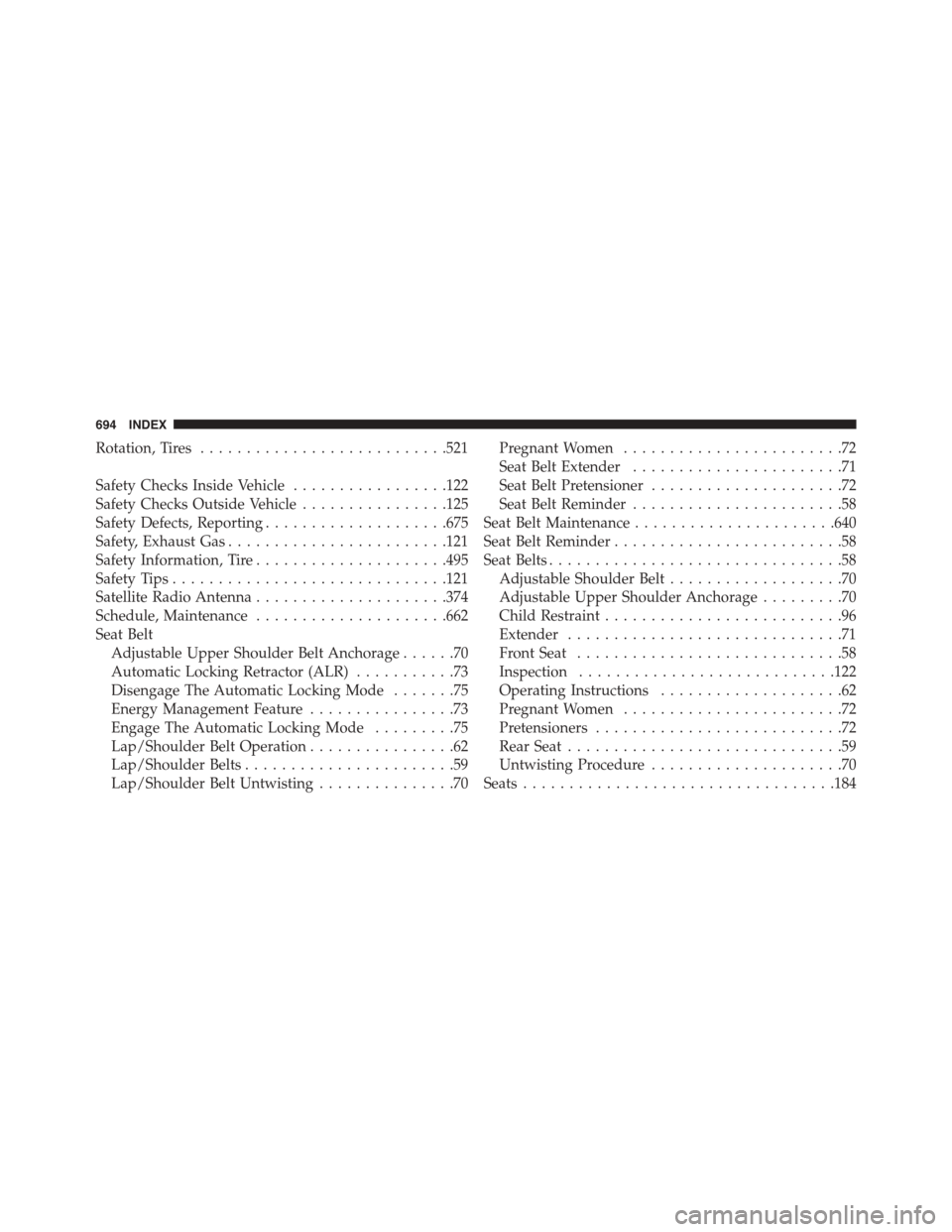
Rotation, Tires...........................521
Safety Checks Inside Vehicle.................122
Safety Checks Outside Vehicle................125
Safety Defects, Reporting....................675
Safety, Exhaust Gas........................121
Safety Information, Tire.....................495
Safety Tips..............................121
Satellite Radio Antenna.....................374
Schedule, Maintenance.....................662
Seat Belt
Adjustable Upper Shoulder Belt Anchorage......70
Automatic Locking Retractor (ALR)...........73
Disengage The Automatic Locking Mode.......75
Energy Management Feature................73
Engage The Automatic Locking Mode.........75
Lap/Shoulder Belt Operation................62
Lap/Shoulder Belts.......................59
Lap/Shoulder Belt Untwisting...............70
Pregnant Women........................72
Seat Belt Extender.......................71
Seat Belt Pretensioner.....................72
Seat Belt Reminder.......................58
Seat Belt Maintenance......................640
Seat Belt Reminder.........................58
Seat Belts................................58
Adjustable Shoulder Belt...................70
Adjustable Upper Shoulder Anchorage.........70
Child Restraint..........................96
Extender..............................71
Front Seat.............................58
Inspection............................122
Operating Instructions....................62
Pregnant Women........................72
Pretensioners...........................72
Rear Seat..............................59
Untwisting Procedure.....................70
Seats..................................184
694 INDEX
Page 702 of 703

INSTALLATION OF RADIO TRANSMITTING
EQUIPMENT
Special design considerations are incorporated into this
vehicle’s electronic system to provide immunity to radio
frequency signals. Mobile two-way radios and telephone
equipment must be installed properly by trained person-
nel. The following must be observed during installation.
The positive power connection should be made directly
to the battery and fused as close to the battery as possible.
The negative power connection should be made to body
sheet metal adjacent to the negative battery connection.
This connection should not be fused.
Antennas for two-way radios should be mounted on the
roof or the rear area of the vehicle. Care should be used
in mounting antennas with magnet bases. Magnets may
affect the accuracy or operation of the compass on
vehicles so equipped.
The antenna cable should be as short as practical and
routed away from the vehicle wiring when possible. Use
only fully shielded coaxial cable.
Carefully match the antenna and cable to the radio to
ensure a low Standing Wave Ratio (SWR).
Mobile radio equipment with output power greater than
normal may require special precautions.
All installations should be checked for possible interfer-
ence between the communications equipment and the
vehicle’s electronic systems.